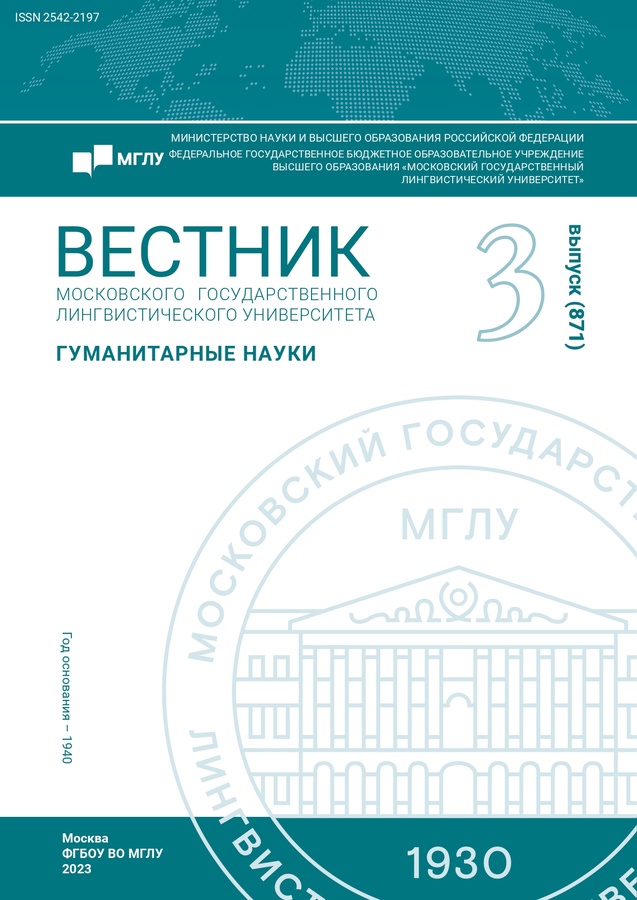Event Frame as Cognitive Schema of Metaphorisation (English resultative and non-resultative constructions)
- 作者: Sorokina T.S.1
-
隶属关系:
- Moscow State Linguistic University
- 期: 编号 3(871) (2023)
- 页面: 123-128
- 栏目: Linguistics
- URL: https://journal-vniispk.ru/2542-2197/article/view/352205
- ID: 352205
如何引用文章
全文:
详细
The article seeks to present a variety of event frame build around the concept “state” as a cognitive schema of metaphorisation. The metaphoric schema is presumably a cross-domain mapping where relations between the source domain and the target domain are treated as specific event metaphors which inherit main features of abstract metaphors. Data of concept-based source domain are given as realized in resultative and non-resultative grammatical constructions.
作者简介
Tatiana Sorokina
Moscow State Linguistic University
编辑信件的主要联系方式.
Email: sotan1462116@gmail.com
Doctor of Philology (Dr. habil.), Professor, Professor at the Department of Grammar and History of English, Faculty of the English Language
俄罗斯联邦参考
- Sorokina, T. S. (2018). Concept “State” as Gestalt and a Cognitive Schema of Linguistic Interpretation. Vestnik of Moscow State Linguistic University. Humanities, 10(803), 161–174. (In Russ.)
- Minsky, M. (1979). A framework for representing knowledge, transl. by O. N. Grinbaum, ed. by F. M. Kulakov. Moscow: Energiya. (In Russ.)
- Fillmore, Ch. (1977). Case for case reopened. Syntax and semantics 8: Grammatical relations. New York: Academic Press.
- Fauconnier, G., Turner, M. (1998). Conceptual Integration Networks. Cognitive Science, 22(2), 133–187.
- Boldyrev, N. N. (2007). Knowledge representation in the system of language. Issues of Cognitive Linguistics, 4, 17–27. (In Russ.)
- Sullivan, K. (2007). Grammar in Metaphor: A Construction Grammar Account of Metaphoric Language: PhD Dissertation. University of California, Berkeley.
- Dejk, T. A. van. (1989). Jazyk. Poznanie. Kommunikacija: collection of works by T. A. van Dejk ; compiled by V. V. Petrov, transl. from English and ed. by V. I. Gerasimov, foreword by Ju. N. Karaulov, V. V. Petrov. Moscow: Progress. (In Russ.)
- Lakoff, G., Johnson, M. (1980). Metaphors We Live By. Chicago: University of Chicago Press.
- Lakoff, G., Johnson, M. Metaphors We Live By. Chicago: University of Chicago Press, 2003. Updated edition.
- Panther, K.-U., Thornburg, L. (2009). On figuration in grammar. In Metonymy and metaphor in grammar (pp. 1–45). Amsterdam ; Philadelphia: John Benjamins Publishing Company.
- Fillmore, Ch. (1989). Grammatical Construction Theory and the Familiar Dichotomies. Language Processing in Social Context (pp. 17–38). Amsterdam: Elsevier.
- Goldberg, A. (1995). Constructions: A Construction Grammar Approach to Argument Structure. Chicago: The University of Chicago Press.
- Boas, H. (2003) A Constructional Approach to Resultatives. Stratford: CSLT Publications.
- Israel, M. (1996). The Way Constructions Grow. Conceptual Structure, Discourse and Language (pp. 217–230). Stanford, CA: CLSI.
- Lakoff, G. (1993). The contemporary theory of metaphor. In A. Ortony (ed.), Metaphor and thought (pp. 202–251). Cambridge University Press.
- Roush, D. (2016). The Expression of the Location Event-Structure Metaphor in American Sign Language. Sign Language Studies, 16(3), 389–432.
- Taverniers, M. (2002). Metaphor. In: Verschueren, J., Östman, J.-O., Blommaert, J., Bulcaen, Ch. (eds.), Handbook of Pragmatics (pp. 1–40). Amsterdam: Benjamins.
- Boldyrev, N. N. (2016). Kognitivnye shemy jazykovoj interpretacii = Cognitive Schemas of Linguistic Interpretation. Issues of Cognitive Linguistics, 4, 10–20. (In Russ.)
补充文件










